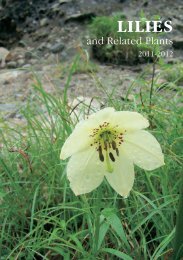LILIES - RHS Lily Group
LILIES - RHS Lily Group
LILIES - RHS Lily Group
Create successful ePaper yourself
Turn your PDF publications into a flip-book with our unique Google optimized e-Paper software.
when there is disturbance by wind or maybe passing or grazing animals. There<br />
is a detailed article on the subject of ants and seed dispersal by Art Guppy in a<br />
recent Bulletin of the North American Rock Garden Society (Vol. 65, 3: 2007). The<br />
Eurasian and eastern North American species have another feature in common and<br />
that is the way in which the leaves are mottled. In the former group the blotching<br />
is in a rather random pattern, often cutting across the main veins in the leaf,<br />
whereas in the case of those western American species which do have mottled<br />
leaves the darker or lighter stains are in the spaces between veins. Returning to<br />
E. dens-canis, one of its great attributes is its variability in flower colour – hence<br />
the reason for the several named clones – from white through shades of pink to<br />
deep purple or violet; some populations are fairly uniform, others very mixed.<br />
The late Kees Sahin has remarked (personal communication) particularly on<br />
the extreme variation in Romania. The Caucasian/north Iranian E. caucasicum<br />
is very similar in morphology but has some distinguishing characteristics; it is<br />
usually the first erythronium to flower and normally has creamy-coloured flowers<br />
with a yellow centre. Perhaps there is a case for dismissing it as a geographical<br />
race of E. dens-canis but there is actually little to be gained in sinking it. This is<br />
easily cultivated but I cannot say the same for E. sibiricum which does not take<br />
to the climate of south-eastern England; I haven’t tried keeping it in the ‘fridge<br />
for the winter, often a useful ploy for growing high altitude or cold climate bulbs.<br />
Although again, this is clearly allied to E. dens-canis it has some distinguishing<br />
features, especially of the stamens and stigma. The far eastern E. japonicum has<br />
attractive dark jagged markings in the centre of the otherwise purplish flower, and<br />
the stamen filaments are different, so it too is distinctive among the Eurasians; it<br />
is somewhat easier to grow than its Siberian relative although I have only ever<br />
achieved small clumps and have not seen impressive plantings of it elsewhere.<br />
The eastern American species should not be lightly dismissed for they do<br />
have what is often referred to as ‘quiet charm’ and the leaf mottling is particularly<br />
attractive. In Britain we find that the light intensity is often too poor early in<br />
the year to encourage the flowers to open properly, certainly in the case of<br />
E. americanum, E. albidum and E. mesochoreum. Choosing a spot under<br />
deciduous trees where they will receive maximum sunlight is the best bet –<br />
or place a cloche over them at the appropriate moment. Being stoloniferous,<br />
propagation is not a problem with these and one can get quite a sizeable colony<br />
in a short space of time. My own favourite of these is E. umbilicatum which<br />
although very similar in overall appearance to E. americanum does, I find, flower<br />
more freely and is less stoloniferous. I await the flowering of E. rostratum (grown<br />
from seed) with interest as it is very rare in cultivation in the UK. The great rarity,<br />
as a wild plant, is E. propullans and for this reason I will strive to maintain and<br />
distribute it: but of this I am sure, it will never receive an AGM!<br />
86




